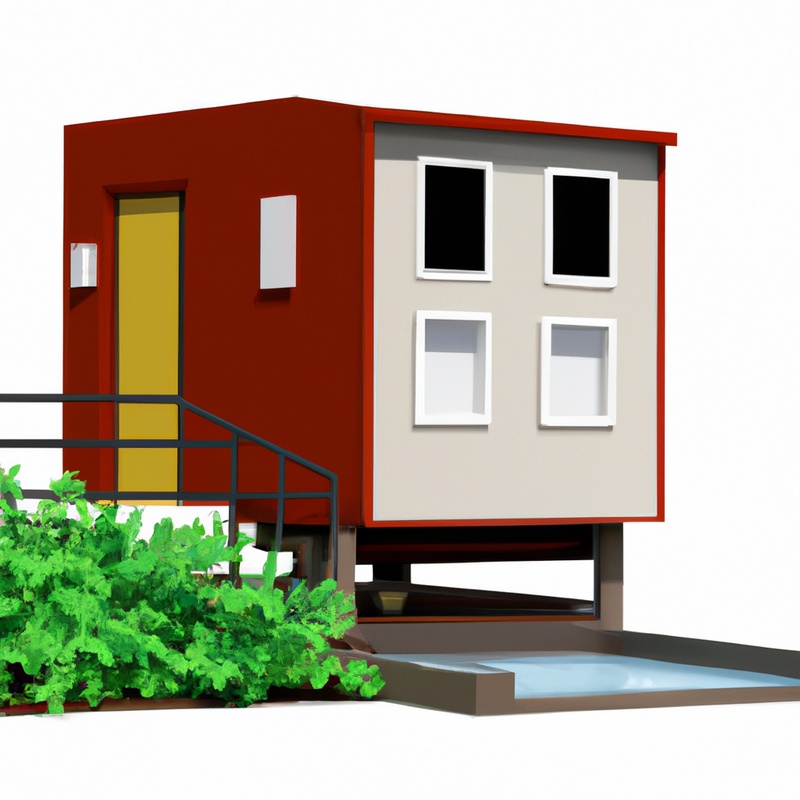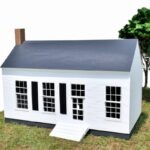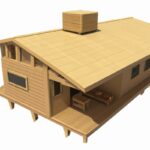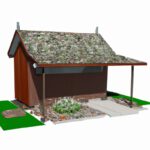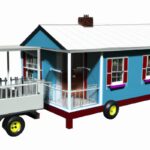Key Takeaways:
- Yes, it is possible to install solar panels on a Tiny House.
- Solar panels can provide sufficient power for most basic needs in a Tiny House.
- Factors like roof space, energy consumption, and budget should be considered before installing solar panels on a Tiny House.
- Hiring a professional is recommended to ensure proper installation and maximize energy efficiency.
Hey there! Are you considering going green with your tiny house? Well, you’ve come to the right place.
Today, I want to talk about an exciting topic—installing solar panels on a tiny house.
Solar panels have become a popular option for homeowners looking to harness the power of the sun. But can you install them on a tiny house?
The answer is yes! In fact, there are numerous benefits to going solar, from reduced energy costs to environmental sustainability and the ability to live off the grid.
But before you grab your toolbox, there are a few considerations to keep in mind. Stick around as we delve into the types of solar panels suitable for tiny houses, calculating energy requirements, installation steps, and maintenance tips.
We’ll also explore the cost considerations and financial incentives available.
So, let’s dive in and shed some light on embracing the sun’s power for your tiny house!
Benefits of using solar panels on a tiny house
Reduced energy costs
Installing solar panels on a tiny house can significantly reduce your energy costs.
Solar panels harness the power of the sun to generate electricity, which can offset or even eliminate your reliance on grid power.
By utilizing this renewable energy source, you can save money on your monthly utility bills.
Additionally, if your solar system produces more energy than your tiny house needs, you may be able to sell the excess energy back to the grid, further reducing your energy costs.

Environmental sustainability
Installing solar panels on a tiny house offers significant environmental sustainability benefits. Solar power is a clean and renewable energy source that reduces reliance on fossil fuels and decreases carbon emissions.
By harnessing the sun’s energy, you can power your house without contributing to air or water pollution.
Solar panels also have a long lifespan and require minimal maintenance, making them a sustainable choice for powering your tiny house. Additionally, generating your own solar power helps to conserve natural resources and promotes a greener lifestyle.

Off-grid living capabilities
Living off-grid is one of the key benefits of installing solar panels on a tiny house.
With solar panels, you can generate your own electricity and be independent from the grid.
This means you won’t have to rely on traditional power sources or worry about power outages.
Solar panels allow you to live in remote areas where electricity may not be readily available.
Additionally, they provide the freedom to live a sustainable and environmentally friendly lifestyle, reducing your carbon footprint.
Considerations before installing solar panels on a tiny house
Roof space and orientation
When considering installing solar panels on a tiny house, one important factor to assess is the available roof space and its orientation.
A sufficiently large roof area is needed to accommodate the solar panels and maximize energy generation.
Additionally, the orientation of the roof should ideally be south-facing in the northern hemisphere (or north-facing in the southern hemisphere) to receive optimal sunlight throughout the day.
It’s essential to evaluate these aspects to ensure efficient utilization of solar energy.

Weight limitations
When installing solar panels on a tiny house, it’s important to consider weight limitations. The weight of the panels, mounting equipment, and wiring must be within the load-bearing capacity of the roof.
Exceeding the weight limit can lead to structural damage and safety concerns.
To ensure you stay within the weight limits, consider lightweight solar panel options, such as flexible solar panels. Additionally, consult a structural engineer or a professional solar panel installer to assess your roof’s capacity and provide guidance on weight limitations.
Energy needs assessment
To assess your energy needs for a tiny house, start by evaluating your daily electricity consumption.
Consider the appliances and devices you use regularly and their power requirements.
Estimate the number of hours each device is used per day to calculate the total energy consumption.
Also, think about any future additions or changes you might make to your energy usage.
This assessment will help determine the size and capacity of the solar panel system you’ll need to meet your energy needs.
Local regulations and permits
Local regulations and permits play a significant role when installing solar panels on a tiny house.
Different areas have their own rules and requirements regarding solar panel installations.
It is vital to research and understand these regulations before starting the installation process.
Some common considerations include obtaining permits, following specific electrical codes, and adhering to zoning restrictions.
Failure to comply with these regulations may result in fines or the need to remove the panels.
It is important to consult with local authorities and professionals to ensure a smooth and legal installation process.
Types of solar panels suitable for tiny houses
Monocrystalline solar panels
Monocrystalline solar panels are a popular choice for tiny houses due to their efficiency and sleek design. These panels are made from a single crystal structure, which allows them to convert sunlight into electricity more effectively.
They are known for their high power output and excellent performance in low-light conditions, making them ideal for off-grid living.
Monocrystalline solar panels also take up less space compared to other types, maximizing the limited roof area of a tiny house. Consider investing in monocrystalline panels if you want a reliable and efficient solar power system for your tiny home.
Polycrystalline solar panels
Polycrystalline solar panels are a popular choice for tiny houses due to their affordability and efficiency.
They are made from multiple silicon crystals, which give them their distinctive blue color.
These panels are slightly less efficient than monocrystalline panels but are a great option for limited roof space.
They work well in various weather conditions, making them versatile for off-grid living.
Polycrystalline panels are a reliable and cost-effective solution for powering your tiny house with solar energy.
Flexible solar panels
Flexible solar panels are a popular option for tiny houses due to their versatility and lightweight design. These panels are made using thin film technology, allowing them to bend and conform to curved surfaces, such as the roof of a tiny house.
They are also easy to install and can be mounted using adhesive or screws.
Flexible solar panels are a great choice for those looking for a flexible and efficient solar solution for their tiny house.
Calculating energy requirements for a tiny house
Determine daily energy consumption
To determine your daily energy consumption for a tiny house, start by compiling a list of all the electrical appliances and devices you regularly use.
This includes lights, refrigerators, heaters, air conditioners, and electronics.
Next, find the power rating in watts for each item, which is usually listed on the product or in the user manual.
Multiply the power rating by the number of hours you use each item daily to calculate the energy usage in watt-hours.
Add up all the watt-hour values to get your total daily energy consumption.
Sizing the solar panel system
To size the solar panel system for your tiny house, you’ll need to consider your daily energy consumption. Start by determining how much energy you use on an average day, including your lights, appliances, and electronics.
Once you have this number, you can calculate how many solar panels you’ll need based on their wattage and efficiency.
Keep in mind that the size of your roof and the available space for solar panels will also play a role in determining the system size. It’s important to find the right balance between meeting your energy needs and the space limitations of your tiny house.
Steps to install solar panels on a tiny house
Assessing roof integrity
Assessing the roof integrity is an important step before installing solar panels on a tiny house. I would recommend having a professional inspect your roof to ensure it is structurally sound and can support the weight of the panels.
They will check for any signs of damage, leaks, or weak areas that could pose a problem.
Additionally, the orientation and angle of your roof should be evaluated to determine if it receives sufficient sunlight for the panels to generate optimal energy. Taking these precautions will help ensure the success and longevity of your solar panel system.
Mounting the solar panels
Mounting the solar panels on a tiny house is a crucial step in the installation process. To ensure proper placement, I recommend assessing the roof’s integrity and suitability for mounting.
It’s important to choose a spot that receives maximum sunlight throughout the day.
Secure the panels using brackets or racks that are specifically designed for this purpose. Make sure they are properly fastened to prevent any movement or damage during heavy winds or storms.
Additionally, consider the weight limitations of your tiny house roof and consult a professional if needed.
Wiring and connecting the system
Wiring and connecting the solar panel system to your tiny house is an essential step in the installation process. It involves connecting the solar panels to an inverter, which then converts the DC power generated by the panels into AC power that can be used to power your appliances and devices.
To ensure a safe and efficient connection, it is recommended to use proper gauge wiring and connectors that are suitable for outdoor use.
Additionally, it is important to follow the manufacturer’s instructions and local electrical codes to ensure compliance and safety. Once the system is wired and connected, it is crucial to test the system to ensure proper function.
This includes checking for any loose connections, monitoring the voltage output, and verifying that the power is being properly distributed to your electrical system.
Regular monitoring and maintenance of the wiring and connections are also important to ensure the longevity and efficiency of your solar panel system. This includes checking for any signs of wear or damage, cleaning the panels as needed, and keeping an eye on the performance of the system.
By properly wiring and connecting the solar panel system, you can harness the power of the sun to meet your energy needs in your tiny house, while also reducing your reliance on traditional energy sources.
Testing and monitoring the system
Testing and monitoring the solar panel system on your tiny house is essential for ensuring optimal performance and identifying any issues. Regularly checking the system allows you to gauge its energy production and efficiency.
You can test the system by measuring the voltage and current generated by the panels, as well as monitoring the battery charge levels.
Utilize a solar monitoring system or app to track real-time performance data and detect any anomalies. Regular inspections and maintenance will help keep your solar panel system running smoothly.
Maintenance and care for solar panels on a tiny house
Cleaning and debris removal
Cleaning and debris removal are important tasks for maintaining the efficiency of solar panels on a tiny house.
Regularly removing dirt, dust, leaves, and other debris will ensure optimal sunlight absorption.
Use a soft brush or cloth to gently clean the surface of the panels and avoid abrasive materials.
Additionally, clearing away any fallen leaves or branches that may accumulate on the panels will prevent shading and obstruction.
Regular inspection and cleaning will help maximize the lifespan and performance of your solar panel system.
Checking for damage or wear
When it comes to the maintenance of your solar panels on a tiny house, checking for damage or wear is crucial. Regularly inspect the panels for any physical damage like cracks or breaks, as well as signs of wear such as discoloration or corrosion.
Look out for loose connections or wires as well.
By visually inspecting your panels, you can identify any issues early on and take necessary action to prevent further damage or decrease in performance. Keeping your panels in good condition ensures optimal energy production and extends their lifespan.
Monitoring energy production
Monitoring the energy production of your solar panels is a key aspect of maintaining and optimizing their performance.
Regularly checking the energy production allows you to ensure that your system is functioning efficiently and identify any issues or discrepancies.
You can monitor energy production through the use of a monitoring system, which provides real-time data on the amount of energy being generated.
By keeping a close eye on the energy production, you can make adjustments as needed to maximize the benefits of your solar panel system.
Cost considerations for installing solar panels on a tiny house
Initial investment
The initial investment to install solar panels on a tiny house can vary depending on several factors.
These factors include the size of the solar panel system, the type of solar panels used, and any additional equipment required.
Typically, the cost can range from a few thousand dollars to tens of thousands of dollars.
It’s important to consider the long-term benefits and potential savings on energy costs when evaluating the initial investment.
Additionally, exploring available financial incentives or grants can help offset the upfront expenses.
Return on investment
The return on investment for installing solar panels on a tiny house can be significant.
While the initial cost may seem high, the long-term savings in energy bills can offset this expense.
Additionally, if you generate excess electricity, you may be able to sell it back to the grid through net metering.
This can further enhance your return on investment and potentially result in a shorter payback period.
Furthermore, solar panels increase the value of your tiny house, providing additional financial benefits if you ever decide to sell.
Available financial incentives or grants
There are several financial incentives and grants available to support the installation of solar panels on tiny houses.
Some options to consider include federal tax credits, state or local rebates, and loan programs specifically designed for renewable energy projects.
Additionally, there are grants and funding opportunities available through nonprofit organizations, foundations, and energy assistance programs.
Researching and exploring these options can help offset the initial investment and make solar panel installation more affordable for tiny house owners.
Final Verdict
Installing solar panels on a tiny house offers numerous benefits.
It reduces energy costs, promotes environmental sustainability, and provides off-grid living capabilities.
However, it is important to consider factors such as roof space and orientation, weight limitations, energy needs assessment, and local regulations before installation.
Monocrystalline, polycrystalline, and flexible solar panels are all suitable options for tiny houses.
Calculating energy requirements, proper installation steps, and regular maintenance are crucial for optimal performance.
While initial costs may be a consideration, the long-term return on investment and available financial incentives make solar panels a worthwhile investment for tiny house owners.
Overall, solar panels offer a practical and eco-friendly solution for powering a tiny house, allowing for a more sustainable and self-sufficient lifestyle.
